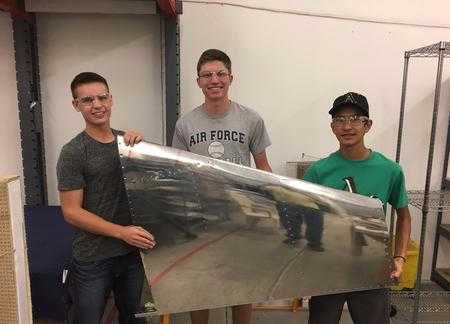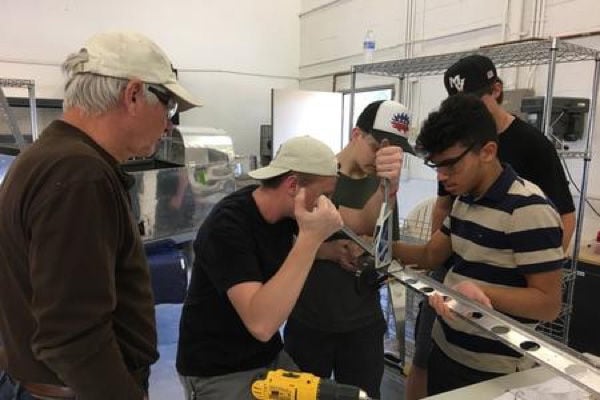For young people with aspirations of careers in aviation, a new local nonprofit is helping those dreams to take flight.
“It is our responsibility as adults to help the children coming along to find ways to be successful in life, and there are many careers in aviation: Not just pilots, but avionics technicians, certified aircraft mechanics, aerospace engineers, flight dispatchers, air-traffic controllers and all kinds of other opportunities,” said Alan Muhs, a commercial pilot and flight instructor. “We want to give kids exposure to some of those opportunities.”
Muhs and fellow pilot Jeff Northcutt co-founded Southern Arizona Teen Aviation last year in an effort to inspire the next generation of aviators by guiding high school sophomores, juniors and seniors through the construction of airplanes.
During a flight career that began when he earned his private pilot’s license more than 41 years ago, Muhs has owned several factory-built airplanes. In 2014, with the help of the members Experimental Aircraft Association Chapter 81, he completed a Van’s Aircraft RV 10 to realize a dream of building a plane. Since then, he has flown it all over the United States, to Mexico and to the Bahamas.
Muhs, Northcutt and five volunteer mentors — Angel “Tito” Sanchez, Mel Jordan, Glenn Brasch, Bob Miller, and Matt North — hope to transfer their knowledge and hands-on experience to a group of students through the construction of a two-seat Van’s Aircraft Model RV12.
“This plane has state-of-the-art avionics including a flat-panel screen, digital radios, autopilot and other technology these kids will encounter if they pursue careers in avionics,” said Muhs.
Construction of the $65,000-plane began in March and will proceed along a regimented program: In May, the students and mentors finished the tail, and the wing kit and fuselage are up next.
Eight students are participating in the program, which meets Sunday afternoons and Monday evenings in a donated hangar and mirrors the calendars of local schools. Another student is slated to join when the program convenes in August; an opening for one student remains since the program is limited at this time.
All the participants are male, though Muhs is encouraging girls to join. He also hopes to add more students as the volunteers continue to hone their teaching skills.
He said it has been rewarding to work with the students, who began the experience by learning to read mechanical drawings, prepare metal parts, handle tools and practice skills such as riveting and drilling. Prior to starting work on the plane, each student built a tool box.
“For the most part, kids don’t get a lot of hands-on experience in school anymore. When I grew up, there was metal shop class and wood shop and auto shop, but kids don’t have those now.
“They need to get their hands on things: To touch and see and feel and do so that they can understand their strengths and weaknesses and what they are interested in. It is difficult to get a good grasp on that when you are just sitting in a classroom,” Muhs said.
Muhs said students also learn valuable skills in leadership and teamwork. Students work in two groups and each day a different student acts as supervisor of his group. The supervisor is responsible for reading plans and giving directions to others in his group.
“It is his job to make sure that things are being done correctly before we move on to the next step. ... Every once in a while things go awry, but they learn to slow down and be patient and give directions and come up with strategies to work together,” he said.
Working with his team has been an amazing experience, according to Jorge Rosado, who will be a junior at Mountain View High School in August.
“It blows my mind that we started from tiny pieces of metal and this will become a plane that we will really be able to fly,” said Rosado, who heard about the opportunity through an aviation course at school.
An aspiring commercial pilot, Rosado said he has always been fascinated by the physics of flight and jumped at the chance to learn more.
“They said they would help us with learning about the different aspects of what makes an airplane fly, rather than just knowing how to fly. ... We have learned so much about every piece of the tail section and what it takes to put them together and the differentials needed to make it safe to fly,” he said
So far, Rosado said that the construction process has made him aware of the multitude of possible careers in aviation. Guest speakers from the aviation community, along with trips to Davis-Monthan Air Force Base and Tucson International Airport, provide additional learning opportunities.
Sebastian Hutton, also a junior at Mountain View, agreed it is a one-of-a-kind opportunity and encourages other students to try it.
“I have never done anything like this is my life. It is unreal that we are building an official product that will someday be in the sky. It is honestly something that I never thought I would be able to do, but the instructors are easy to understand and very concise,” Hutton said.
Moving forward, Muhs said the nonprofit, which is all-volunteer with no paid staff, seeks to become self-sustainable.
“Any money that is donated goes into buying airplane parts and when we are done we will sell the airplane and use the proceeds to buy the next kit,” Muhs said.
In the meantime, the nonprofit is in need of additional funding to complete its initial airplane. It has raised $15,000 and seeks to raise an additional $50,000 to finish the project by May 2108.
“It is interesting that when we talk to adults and tell them what we are doing, they all wish they could have done something like this in high school.
“Lecturing and class time are important, but we do kids a disservice by not letting them experience some of the things they do with us. It is our job as adults who have been fortunate to have great lives and careers to expose them to as many different experiences as we can,” he said.





